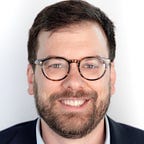Introducing Innovation Ecology
“Hiking — I don’t like either the word or the thing. People ought to saunter in the mountains — not hike! … Now these mountains are our Holy Land (sainte terre), and we ought to saunter through them reverently, not ‘hike’ through them.” — John Muir
When I first encountered this wonderful little quote from one of my longtime heroes, I was taken aback. Do you mean to say that the namesake of one of the most famous hiking trails in the world, and the inspiration of so many hikers, was, in fact, against hiking? This may seem a bit odd, but I think I’ve come to see what Muir was getting at. There are better, and worse, ways to experience the natural world, and hiking, at least the way it was practiced in Muir’s day, is in the latter!
To see the world like Muir — or St. Francis, or Lao Tzu — did, a world that opens “from wonder unto wonder”, requires one to walk a little slower, still oneself, look around, and reflect. What Muir called “hikers” — those geared-out groups, huffing full speed from parking lot to peak so that they can add another sticker to their RV — is the furthest thing from what he had in mind. In fact, he saw their practice as akin to a desecration — an irreverent blindness to the sacred. In Muir’s view, “hikers” are at best missing, and at worst, destroying, the beauty of the ecosystem they are in. He spent his life trying to model a better way.
Muir’s Holy Land was the Sierra Nevada mountains. Mine is a little stretch of sand on the southern tip of the Great Lakes: the Indiana Dunes. People are surprised to hear that this region, a short ride from Chicago and a seagull’s hop from Gary Indiana’s steel mills (think “Rudy”), is one of the most ecosystem-diverse swaths of North America. If you haven’t yet visited, perhaps its recent elevation to full National Park status will convince you to? In fact, this is the place where the word “Ecology” was first used in the English language, by a sauntering, and immensely interesting scientist from the University of Chicago.
On summer weekends in the 1890s, Henry Chandler Cowles would pack sandwiches, round up his friends and students, and take a buggy from Hyde Park down to the Indiana Dunes for “field expeditions’’ — sometimes-multi-day affairs that combined elements of a scientific expedition with a camping trip and a picnic at the beach. Participants would make camp on the beach or just inland, spend their days cataloging, measuring, and observing the various minerals and flora, and spend their nights around driftwood bonfires on the lakeshore. (This is what doctoral research looks like today, too, right?)
Over the years, these trips with friends became the cornerstone of Cowles’ research at the University of Chicago and part of the foundation of modern ecology. His saunters through the Dunes and his close observations, especially of its plants, revealed what he later called the Theory of Ecological Succession — the process whereby one ecosystem gives way to another, which shifts into another, and again to another, under the pressure of particularly harsh or demanding environments. Shifting shoreline sands give way to hardy grasses, then fast growing pine & cottonwood glades, and finally immovable oak savannas.
So what has this all to do with Innovation? Surely you can guess!
To start: If you’re reading this, I bet you’ve heard someone use the term “Innovation Ecosystem”. At TED talks, pitch events, and regional development conferences, speakers often use this term to signify the fragile, interconnected nature of innovation. In too many instances it becomes just another variation of corpspeak at the top of a powerpoint slide, between “leveraging synergies”, “monetizing assets”, and “building shareholder value”. Despite how ubiquitously it is used, however, I wonder how often we actually approach innovation in the way that this term would invite us to — using the techniques and habits of mind that ecologists use to study the natural world.
The purpose of this project is to do just that. We’ll try to think like ecologists as we approach three general sets of questions:
- What are the key elements of an innovation ecosystem? How do they interact? How might you measure them?
- How does an innovation ecosystem develop? What stages does it go through? What slows down the process? What can speed it up?
- How can we harness innovation ecosystems to promote human flourishing? For example, how might we utilize innovation ecology to find breakthrough research, up-and-coming inventors, promising solutions to important problems? Or, for inventors and entrepreneurs, how might we use these tools to find the team members, investors, and partners we need to succeed?
Following Henry Chandler Cowles, I’ll explore these questions through a series of “Saunters”, “Field Expeditions”, and “Labs”, with an eye toward exploring how innovation ecosystems behave and develop, and how we can better understand and harness them. In Saunters, I’ll take a more ambling, wide-angle approach to broader topics like, for example, the elements of an innovation ecosystem, or intellectual frameworks for evaluating ideas. In Field Expeditions, I’ll zoom in a bit to reflect on more specific topics, like patent landscape, and ecosystems, like the biotech scene in Chicago or Atlanta. Lastly, in Labs I’ll share different techniques and frameworks that I’ve picked up along the way for better understanding and navigating whatever innovation ecosystem you might find yourself in.
Rather than an academic pursuit — for which I am manifestly unqualified! — my goal with this project is to explore practical topics in a practical way. My hope is that you leave with some useful perspectives and tools, whether you are an entrepreneur, an aspiring venture capitalist, a graduate student, or a professor.
Thanks for reading!
